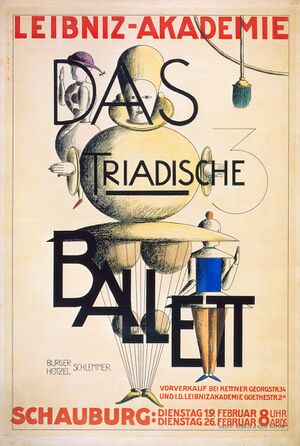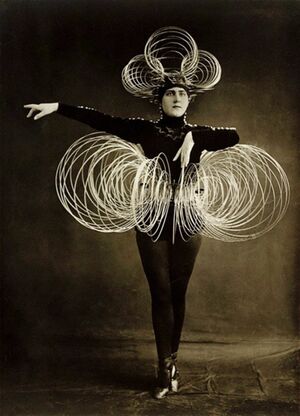The Triadic Ballet, created by Oskar Schlemmer, became the most widely performed avant-garde artistic dance of its time. While the ballet toured between 1921 and 1929, it helped to spread the ethos of the Bauhaus.
The Bauhaus school (Q76) was a German art school that combined crafts and the fine arts. It became famous for its approach to design, which attempted to unify the principles of mass production with individual artistic vision and strove to combine aesthetics with everyday function.
Inspired in part by Arnold Schoenberg’s Pierrot Lunaire and his observations and experiences during the First World War, the painter and sculptor Oskar Schlemmer (Q30528) began to conceive of the human body as a new artistic medium. He saw ballet and pantomime as free from the historical baggage of theatre and opera and thus able to present his ideas of choreographed geometry, of man as dancer, transformed by costume, moving in space.
Oskar Schlemmer saw the movement of puppets and marionettes as aesthetically superior to that of humans, as it emphasised that the medium of every art is artificial. This artifice could be expressed through stylised movements and the abstraction of the human body. His consideration of the human form (the abstract geometry of the body, for example a cylinder for the neck, a circle for head and eyes) led to the all-important costume design, to create what he called his ‘figurine'. He saw the modern world driven by two main currents, the mechanised (man as machine and the body as a mechanism) and the primordial impulses (the depths of creative urges). He claimed that the choreographed geometry of dance offered a synthesis, in which the Dionysian and emotional origin of dance becomes strict and Apollonian in its final form.
From 1923 Oskar Schlemmer directed the theatre workshop, an essential subject at the Bauhaus and whose research gave rise to projects that played with projections of light and shadow, emphasised the study of the human body, and experimented with puppets and marionettes and the constant change of scenery to destabilise theatrical conventions.
The Triadic Ballet (Q30527) is considered one of the most significant dance creations of the 20th century. Schlemmer turned the Bauhaus theatre workshop into a laboratory in constant search of the relationship between human and geometry. The workshop was divided into artistic creation and the creation of sets and costumes. Ballet and pantomime were the starting point as they were considered by Schlemmer himself as free forms that do not depend on the word, sound or story. In his works converge art, abstraction, mechanisation, mathematics and metaphysics. The ballet fuses dance, music, pantomime and costumes. The costumes of the Triadic Ballet limited the movement of the dancers due to the weight of the materials themselves, glass and metal among others. The forms of geometric lines of the costumes and the masks that transformed the dancers into anonymous characters resulted in structures with comical and clumsy movement. Schlemmer was not looking for the expressive virtuosity of the human body, but rather the visual interplay of basic elements, elementary forms of scenographic representation.
The idea of the ballet was based on the principle of the trinity. It has three acts, three participants (two male, one female), twelve dances and eighteen costumes. Accompanied by the music of Debussy, Haydn, Mozart, Händel and Hindemith, each act was defined by a colour. The first act is a burlesque arranged on a yellow stage, the second shows a series of solemnities on a pink stage and the last act is a mystical meditation on a black stage. The number three represents collectivity, the three dimensions of space, the basic geometric shapes (sphere, cube and pyramid), the basic colours (red, blue and yellow) and the three units (costumes, dance and music). Here Schlemmer openly makes manifest the search for lost harmony through abstraction, the limitation of movement caused by costumes and the idealisation of figures and spaces.
With the beginning of National Socialism in Germany, Schlemmer’s designs were considered obscene and provocative (Entartete Kunst) because they did not fit the image of the new absolutist regime. Schlemmer, in social exile, died in 1943 in Baden-Baden, Germany.
David Bowie declared himself an admirer of Schlemmer’s works and his colourful, geometric and dynamic compositions, which inspired Bowie’s spectacular costumes for the 1974 Ziggy Stardust character – a style icon even today.


